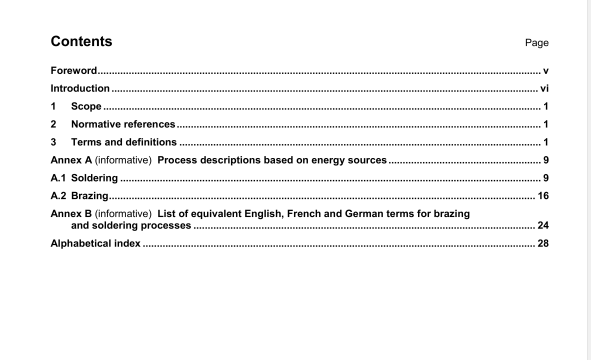ISO 857-2 pdf download – Welding and allied processes – Vocabulary – Part 2: Soldering and brazing processes and related terms.
3.5.2.2
diffusion zone transition zone
layers formed during soldering or brazrng with a chemical composition that is different from that of the parent material(s) and that of the solder or braze metal
3.5.2.3
solder or braze metal
metal formed by the soldering or brazing process
NOTE Because the filer metal has mallet its chenical composition may change due to reactions with the parent material(s).
3.6
solderIng/brazIng procedures
3.6.1
manual soldering or brazing
soldering or brazing in which all operations are carried out manually
3.6.2
mechanized soldering or brazing
soldering or brazing in which all the main operations, except the handling of the workpiece, are carried out mechanically
3.6.3
automatic soldering or brazing
soldering or brazing In which all operations, mciudlng all auxiliary operations such as changing the woricpiece, are carried out automatically
3.6.4
soldering and brazing with filler metal applied
process during which the components are heated up to the soldering or brazing temperature in the area of the joint, and the filer metal Is brought to its melting point mainly by contact with the components to be soldered or brazed
3.6.5
soldering or brazing with filler metal inserted
process during wtiich the filler metal is placed .n the area oW the joint before heating, and is then heated to the soldering or brazing temperature together with the components to be soldered or brazed
3.6.6
dIp soldering or brazing
process during which the components to be soldered or brazed are dipped in a bath of molten salt, molten flux or molten filler metal
3.6.7
solderIng or brazing with components coated with filler metal
process during which the filler metal is applied before soldering/brazing by coating (e.g by plating, electrocoating or vapour deposition)
A.1.6.2 Reflow solderIng with heating by hot gas
After the application of flux and filler metal, the components (e.g. Printed-circuit boards) are healed by means of a hot gas flow. For most components, a filler metal cream or paste is used.
kl.6.3 Reflow soldering with IR or laser heating
The components (e.g. printed-circuit boards) are heated by means of infrared or laser radiation. Infrared radiation heats the whole component. Laser radiation heats only the area of the joint.
A,1.6.4 Reflow soldering with heating by means of vapour condensation (vapour-phase soldering) A condensing vapour is used to heat up the components (e.g. printed-circuit boards) to the soldering temperature. The temperature will not exceed the boiling point of of the liquid used to produce the vapour
A.2 Brazing
A.2.1 Brazing using liquids for heating
A.2.1.1 Dip brazing (914)
The components to be brazed are heated by dipping them In a bath of molten filler metal The bath has to be made of a suitable material (ceramic material or graphite) A flux covering is needed for the components before they are dipped in the bath.
A.2.1.2 Salt-bath brazing (915)
The components are heated by dipping them ii a bath containing a mixture of molten salts. The bath is made of a suitable materiaL Many salt mixtures have also a flux action. The composition of the salt mixture depends on the nature of the parent metal and of the filler metal Filler metal preforms are placed in the immediate proximity of the joint area prior to immersion.
A.2.1.3 Flux-bath brazing
flux-bath brazing involves the immersion of the components in a bath of suitably active molten flux. Filler metal preforms are placed in the immediate proximity of the joint area prior to immersion.
A2.2 Flame brazIng (912)
A gas-operated torch is used as the heal source. The torch is adjusted to produce a neutral or slightly reducing flame. The way the heat is applied depends on the nature of the joint being brazed and the filer metal used
for manual brazing, generally the torch is moved so as to heat the components to be brazed as uniformly as possible in the joint region;
— for mechanized or automatic brazing. normally the components are moved (see Figure A.9);
— suitable gaseous fuels are acetylene, propane, hydrogen or natural gas, burnt together with oxygen, compressed air or aspirated air.
ISO 857-2 pdf download – Welding and allied processes – Vocabulary – Part 2: Soldering and brazing processes and related terms
